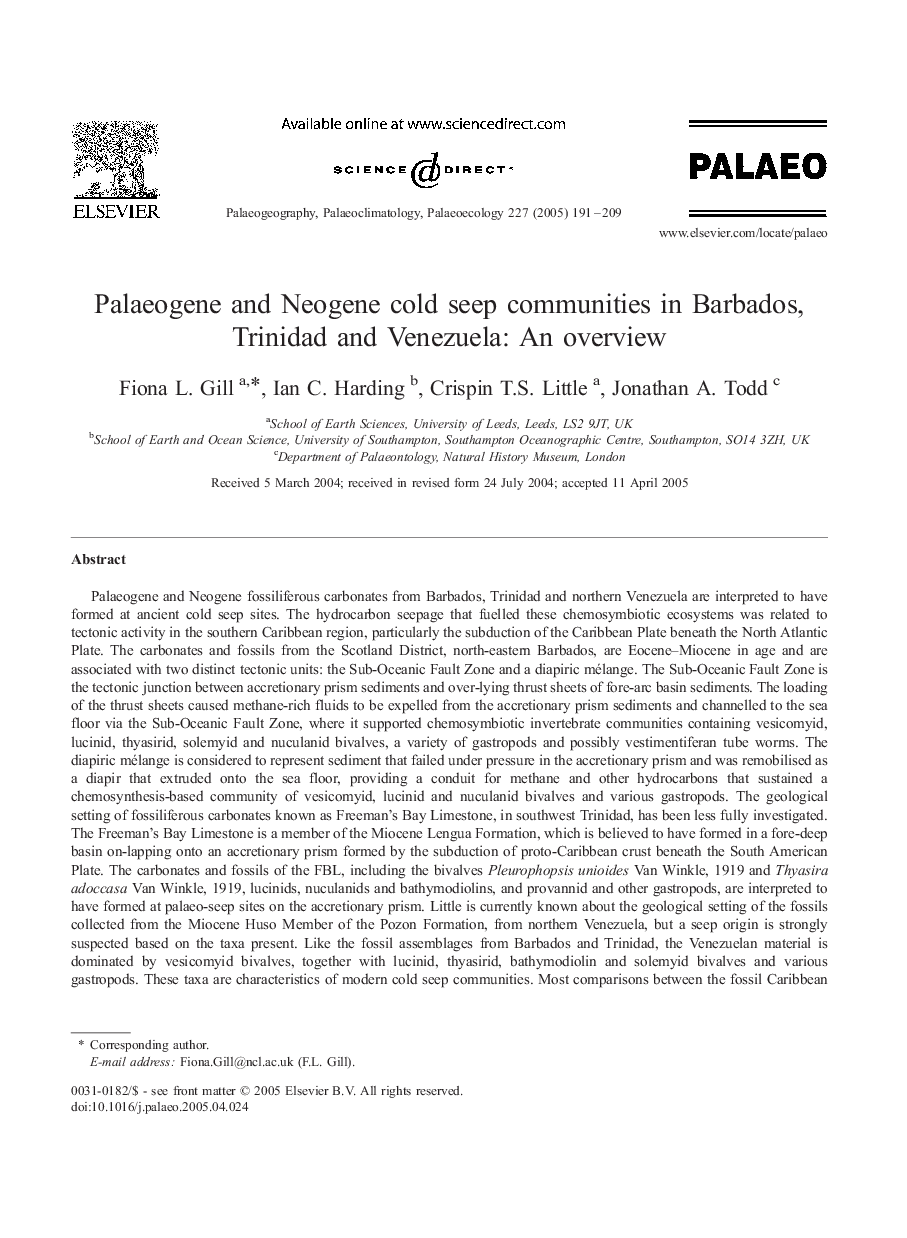| کد مقاله | کد نشریه | سال انتشار | مقاله انگلیسی | نسخه تمام متن |
|---|---|---|---|---|
| 9462998 | 1622385 | 2005 | 19 صفحه PDF | دانلود رایگان |
عنوان انگلیسی مقاله ISI
Palaeogene and Neogene cold seep communities in Barbados, Trinidad and Venezuela: An overview
دانلود مقاله + سفارش ترجمه
دانلود مقاله ISI انگلیسی
رایگان برای ایرانیان
کلمات کلیدی
موضوعات مرتبط
مهندسی و علوم پایه
علوم زمین و سیارات
فرآیندهای سطح زمین
پیش نمایش صفحه اول مقاله

چکیده انگلیسی
Palaeogene and Neogene fossiliferous carbonates from Barbados, Trinidad and northern Venezuela are interpreted to have formed at ancient cold seep sites. The hydrocarbon seepage that fuelled these chemosymbiotic ecosystems was related to tectonic activity in the southern Caribbean region, particularly the subduction of the Caribbean Plate beneath the North Atlantic Plate. The carbonates and fossils from the Scotland District, north-eastern Barbados, are Eocene-Miocene in age and are associated with two distinct tectonic units: the Sub-Oceanic Fault Zone and a diapiric mélange. The Sub-Oceanic Fault Zone is the tectonic junction between accretionary prism sediments and over-lying thrust sheets of fore-arc basin sediments. The loading of the thrust sheets caused methane-rich fluids to be expelled from the accretionary prism sediments and channelled to the sea floor via the Sub-Oceanic Fault Zone, where it supported chemosymbiotic invertebrate communities containing vesicomyid, lucinid, thyasirid, solemyid and nuculanid bivalves, a variety of gastropods and possibly vestimentiferan tube worms. The diapiric mélange is considered to represent sediment that failed under pressure in the accretionary prism and was remobilised as a diapir that extruded onto the sea floor, providing a conduit for methane and other hydrocarbons that sustained a chemosynthesis-based community of vesicomyid, lucinid and nuculanid bivalves and various gastropods. The geological setting of fossiliferous carbonates known as Freeman's Bay Limestone, in southwest Trinidad, has been less fully investigated. The Freeman's Bay Limestone is a member of the Miocene Lengua Formation, which is believed to have formed in a fore-deep basin on-lapping onto an accretionary prism formed by the subduction of proto-Caribbean crust beneath the South American Plate. The carbonates and fossils of the FBL, including the bivalves Pleurophopsis unioides Van Winkle, 1919 and Thyasira adoccasa Van Winkle, 1919, lucinids, nuculanids and bathymodiolins, and provannid and other gastropods, are interpreted to have formed at palaeo-seep sites on the accretionary prism. Little is currently known about the geological setting of the fossils collected from the Miocene Huso Member of the Pozon Formation, from northern Venezuela, but a seep origin is strongly suspected based on the taxa present. Like the fossil assemblages from Barbados and Trinidad, the Venezuelan material is dominated by vesicomyid bivalves, together with lucinid, thyasirid, bathymodiolin and solemyid bivalves and various gastropods. These taxa are characteristics of modern cold seep communities. Most comparisons between the fossil Caribbean and modern seep fauna are necessarily at the generic or family level, although in some cases, individual species are found at both ancient and modern seep sites. For example, the gastropod Cataegis meroglypta is found in seep carbonate from the SOFZ of Barbados and the FBL of Trinidad as well as at modern seeps on the Barbados Prism. At the generic level, this study has revealed the first fossil occurrences of Abyssochrysos and Provanna in the Caribbean. Such temporal and spatial links further the understanding of both local and global patterns of biogeographic distribution of cold seep fauna.
ناشر
Database: Elsevier - ScienceDirect (ساینس دایرکت)
Journal: Palaeogeography, Palaeoclimatology, Palaeoecology - Volume 227, Issues 1â3, 28 October 2005, Pages 191-209
Journal: Palaeogeography, Palaeoclimatology, Palaeoecology - Volume 227, Issues 1â3, 28 October 2005, Pages 191-209
نویسندگان
Fiona L. Gill, Ian C. Harding, Crispin T.S. Little, Jonathan A. Todd,